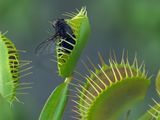What Is An Animal That Only Eats Meat
A carnivore is an organism, in nearly cases an animal, that eats meat. A carnivorous animal that hunts other animals is called a predator; an beast that is hunted is called prey. An animal's nutrition determines where it falls on the food concatenation, a sequence of organisms that provide energy and nutrients for other organisms. Each nutrient chain consists of several trophic levels, which describe an organism's function in an ecosystem. Carnivores and omnivores occupy the tertiary trophic level. An omnivore, such as a man, is an organism that eats plants and animals. Many carnivores become their free energy and nutrients past eating herbivores, omnivores, and other carnivores. The animals that eat secondary consumers, similar owls that eat rodents, are known as tertiary consumers. Carnivores that have no natural predators are known as apex predators; they occupy the pinnacle of the nutrient chain. Not all carnivores are predators. Some carnivores, known as scavengers, feed on the carcasses of already-dead animals. Vultures, for example, are scavengers. Carnivores are divided into three different categories based on what percentage of their nutrition consists of meat. Animals that go 70 pct or more of their nutrition from meat are called obligate carnivores or hypercarnivores. Animals whose nutrition consists of about 50 percent meat are called mesocarnivores. Animals whose diet is only about 30 percent meat are called hypocarnivores. Carnivores vary in shape and size, simply they ofttimes share similar traits. For example, most carnivores accept sharp teeth adapted for capturing casualty and vehement flesh. Additionally, many carnivores accept relatively large brains. Carnivores also have a unmarried stomach chamber and a simple digestive system, unlike herbivores, who oftentimes have a stomach with multiple chambers and a specialized digestive system. Not all carnivores are animals. There are almost 600 species of carnivorous plants, the about well-known being the Venus flytrap ( Dionaea muscipula ). Most carnivorous plants consume insects, just some larger plants feast on small animals, such as frogs or mice. Carnivores play an important role in keeping ecosystems counterbalanced. Predators keep populations of casualty species from condign too large. Scavengers like vultures help preclude diseases from spreading past eating the remains of dead animals.

The Venus flytrap (Dionaea muscipula) is likely the best known of around 600 species of cannibal plants. Here a housefly (Musca domestica) is caught past a Venus flytrap.
Photograph by Ernie James/Alamy Stock photo
Substantive
organism that tin produce its ain food and nutrients from chemicals in the atmosphere, usually through photosynthesis or chemosynthesis.
Noun
organism that eats meat.
Substantive
community and interactions of living and nonliving things in an expanse.
Noun
group of organisms linked in order of the nutrient they eat, from producers to consumers, and from casualty, predators, scavengers, and decomposers.
hypercarnivore
Substantive
organism that depends on meat for more than lxx percent of its diet.
hypocarnivore
Noun
organism that depends on meat for less than 30 pct of its diet.
mesocarnivore
Noun
organism that depends on meat for at least 50 pct of its diet.
obligate carnivore
Noun
organism that depends entirely on meat for food, nutrition, and survival.
Noun
organism that eats a diverseness of organisms, including plants, animals, and fungi.
predator
Substantive
animal that hunts other animals for food.
prey
Noun
animate being that is hunted and eaten by other animals.
Substantive
organism that eats dead or rotting biomass, such equally fauna flesh or institute material.
vulture
Noun
bird that mostly eats dead animals.
Source: https://www.nationalgeographic.org/encyclopedia/carnivores/
Posted by: hiserwarge1965.blogspot.com

0 Response to "What Is An Animal That Only Eats Meat"
Post a Comment